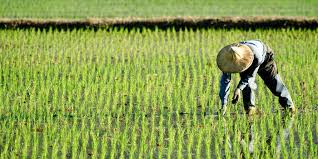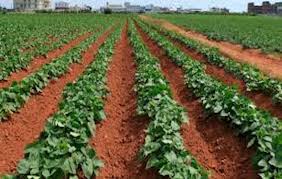Soil is the uppermost layer of the earth, which supports the growth of higher plants by providing a medium for plant roots and supplying essential elements to the entire plant.
The soil regulates water supplies in rivers, lakes, and underground aquifers; recycles raw materials as humus; and serves as a habitat for soil organisms, including beneficial organisms, predators, preys, producers, consumers, and parasites.
In Nigeria, variations in the patterns of soil distribution result in marked regional differences in agricultural specializations. Soil type, fertility, and present or potential soil management systems have considerable influence on agricultural production.
Regional variations in soil types often influence the prospects of growing particular crops in different parts of the country. Fertility levels also affect soil types and traditional soil management techniques used in their maintenance.
Crop productivity is strongly dependent on the physical, chemical, and biological conditions of the soil.
Read Also: Comprehensive Guide on Dry Beans Production
Physical Soil Factors Affecting Crop Production

These include the soil’s texture, structure, porosity, and bulk density.
1. Soil Texture
Soil texture refers to the relative proportions of sand, silt, clay, and gravel/stone particles in the soil. The proportion of solid soil particles provides a useful guide to a soil’s potential for agricultural crop production, as it exerts a major influence on soil characteristics.
Soil texture affects water-holding capacity, temperature, drainage, and nutrient retention capacity. It also influences the efficacy of soil-applied pre-emergence herbicides and other pesticides.
Soils are classified as light (sandy, workable), medium (loamy, most workable), or heavy (clay, unworkable) based on texture, which relates closely to the workability of the soil.
2. Soil Structure
Soil structure is the arrangement of soil particles (sand, silt, clay). It influences soil tilth, root growth, gaseous exchange, drainage, water infiltration, and the efficiency of water and nutrient uptake by plants.
Structural stability refers to the ability of soil to resist deformation when wet, and it is influenced by factors such as clay content, lime, iron oxides, and humus. Soil structure can be improved by adding organic matter such as farmyard manure, crop roots, and residues.
3. Soil Porosity
Soil porosity is the percentage of soil volume filled with air when fully drained. Pore sizes include micropores (containing water unavailable to crops), mesopores (containing water available to plants), and macropores (allowing air entry after wetting). Soil porosity affects water infiltration, water-holding capacity, and aeration, which influence organic matter content and soil health.
4. Soil Bulk Density
Bulk density refers to the mass of soil per unit volume, determined by the volume of pore spaces in the soil. High bulk density is associated with soil compaction and reduced workability. Bulk density affects mechanical cultivation, especially in dry weather conditions.
5. Soil Water
Water is held in the soil in three forms: capillary water (held by surface tension forces), gravitational water (drains under gravity), and hygroscopic water (adsorbed by soil particles). Soil water is critical for nutrient absorption, microbial activities, organic matter decomposition, and maintaining optimal growth and development.
Chemical Factors of Soil Affecting Crop Production

The chemical properties of soil play a crucial role in crop nutrition.
1. Soil Organic Matter (SOM)
Soil organic matter consists of fresh organic material and humus, exerting a profound influence on crop nutrients, soil structure, and cultivation. Organic matter serves as a source of essential nutrients, particularly nitrogen. It enhances soil structure, water-holding capacity, pH, and exchangeable capacity.
2. Soil pH
Soil pH indicates the degree of acidity or alkalinity in the soil, influencing chemical reactions in the soil. Soil acidity may result from organic acids or loss of calcium. Regular pH analysis is essential to determine lime requirements.
3. Available Plant Nutrients
Plant nutrients are categorized into macro-, meso-, and micro-nutrients, with macro-nutrients (nitrogen, phosphorus, potassium) being essential for crop growth. Meso-nutrients include calcium, magnesium, and sulfur, while micro-nutrients, such as copper and zinc, play roles in various physiological processes.
Read Also: Life Cycles and Alternation of Generations in Phytophthora and Rhizopus
Biological Factors of Soil Affecting Crop Production

Soil fauna and flora influence crop production through complex interactions.
1. Soil Fauna
Beneficial organisms, such as earthworms, aid in the breakdown of organic matter, improving soil aeration and water movement. Damaging organisms, including wireworms and nematodes, can negatively affect crop health.
2. Soil Flora
Pathogens such as bacteria, fungi, and viruses may cause soil-borne diseases in crops, affecting their productivity.
Spatial Distribution of Soil Types in Nigeria
Various soil types are found across Nigeria’s ecological zones.
1. Alluvials
Alluvial soils include marine deposits in mangrove areas, coastal alluvials with high sulfide content, and alluvial soils from riverine deposits. They are suitable for crops like coconuts under controlled drainage.
2. Ferrasols
Ferrasols, also called acid sands, are found in southern forest zones and mid-Western and eastern regions of Nigeria. They are of low fertility but have potential for mechanical agriculture.
Ferruginous Tropical Soil
These soils, formed from crystalline acid rock, are found in the forest and savanna zones. They are fertile and suitable for crops like cocoa, maize, yam, and groundnut.
1. Lithosols
Lithosols are of local significance, often associated with ferruginous soils, and require protection from erosion.
2. Vertisols
Vertisols are clay-rich soils with great agricultural potential, though their use is limited due to difficulty in tillage. Dry-season guinea-corn is commonly grown in these soils.
3. Regosols
Regosols are semi-arid soils with consistent organic matter content at various depths, used primarily in areas with dry climates.
Generally, organic matter and nutrient content in soils decline during continuous production or cropping but increase under fallow periods. Several methods, such as crop rotations, shorter fallows, and the use of crop residues, are employed by farmers to maintain soil fertility.
This article highlights the effects of soil properties on agricultural crop production and productivity, as well as the distribution and agricultural value of soil types in Nigeria.
Do you have any questions, suggestions, or contributions? If so, please feel free to use the comment box below to share your thoughts. We also encourage you to kindly share this information with others who might benefit from it. Since we can’t reach everyone at once, we truly appreciate your help in spreading the word. Thank you so much for your support and for sharing!
Frequently Asked Questions
We will update this section soon.

